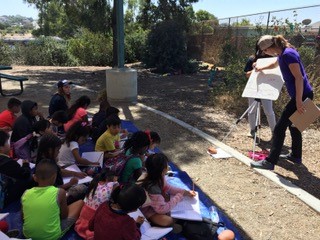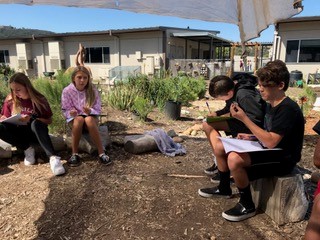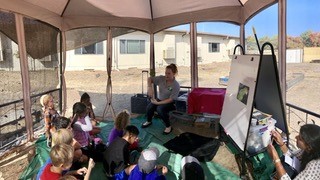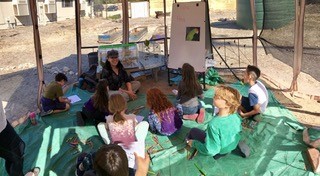Bringing your classroom outdoors
By Mary Zanotelli
In light of COVID-19, with new concerns and requirements for student and teacher safety, schools are being challenged to consider alternatives to traditional classrooms and science labs. As science teachers, whether formal or informal, we can make excellent use of an asset that is inexpensive, therapeutic, and currently considered a safer option than the classroom: the great outdoors!

WHY OUTDOORS?
Open-air school rooms are not a new idea. Other countries have been utilizing outdoor learning for centuries. According to the New York Times, during the tuberculosis outbreak of the early 1900s, 65 open-air schools were established around the United States...even in cold climates...to mitigate transmission of the disease to children.
Besides providing adequate space and ventilation, being outdoors has additional health benefits. Research has shown that children need nature to thrive and that outdoor learning opportunities have many positive outcomes:
- Mental health benefits
- Stress reduction
- ADHD improvement
- Happier students
- Reduction in eye strain
- A level playing field for students of various languages, abilities, achievement levels, and range of learning styles
- Classroom learning applications to the real world
- Increased focus and attention
- Physical activity
- Exposure to Vitamin D
- Development of self-discipline
- Appreciation for and enjoyment of the learning process
- Social-emotional learning
- Development of respect for nature
- Engagement and participation
- Improvements in problem-solving, critical thinking, asking questions, and making connections
According to Greenschoolyards.org, “Green schoolyards foster children’s social, physical, and intellectual growth and health by providing settings for curiosity, collaboration, imagination, exploration, adventure, and wonder.”
There is also the matter of equity; “The impact of systemic racism shows up in who has regular access to the benefits of nature; in how parks and green spaces have been designed, distributed and programmed; and in policies that discourage use and create safety concerns for Black, Indigenous, Latinx and other People of Color,” according to the Children and Nature Network. Bringing classrooms outdoors may help broaden nature access across socio-economic, racial and cultural lines.
For these reasons and more, California’s Blueprint for Environmental Literacy promotes the teaching of multiple subjects outdoors, with the goal that all students spend a minimum of 40 hours of school time outdoors per year.
So how do science teachers bring their lessons to an outdoor setting?


OUTDOOR CLASSROOMS
Educators who have access to an outdoor space might consider creating an outdoor classroom.
Outdoor classrooms can be as simple or as elaborate as desired. In most cases, creating an outdoor classroom is easy and inexpensive, with virtually no added cost or work. Using a playground area, lunch court or garden, staff can erect a canopy or a sun shade. A tarp allows students to sit on the ground. Benches, picnic tables, chairs, logs, stepping stones or stumps can also be used for seating. A wheeled whiteboard, clipboards, writing instruments, and journals complete the setup. Of course, depending on the weather, appropriate clothing and water bottles are recommended. The teacher may also want to invest in a portable voice amplifier.
Educators who don’t have suitable outdoor space on school grounds could set up a similar temporary learning space in a nearby park.



TEACHING OUTDOORS
Learning looks different outdoors, and teachers need to establish expectations that outdoor classrooms are still classrooms and subject to the same agreements as other classrooms. Teachers and students can also come up with new agreements for outdoor learning. Additional expectations may include:
- Stay behind the teacher
- Always walk
- Stay on the path
- Use quiet voices so as not to disturb other people
- Stay where you can see the teacher
- Be kind to nature (Touch gently, take only memories, keep our hands to ourselves, etc.)
- Leave the area better than we found it
To avoid having students correlate going outside with recess or break time, teachers may want to access the outdoor learning area through a different entrance than that used for breaks.
Expect distractions, whether in the form of other people walking nearby, a bug crawling into the teaching space, or a bird calling overhead. In many cases, these can be teachable moments, unplanned opportunities for students to investigate or for the educator to offer insights.
Other aspects of outdoor teaching can be prepared for ahead of time. In order to set themselves and their students up for success, educators should:
- Explore the outdoor area ahead of time to make a plan
- Review and identify lessons that can be taught outdoors
- Let the office know where the class will be in case of late arrivals or early pickups
- Bring a first aid kit
- Practice routines
- Establish time limits and share them with students
- Set physical boundaries
- Start with shorter visits
- Give clear tasks
- Use a call back signal to gather students or to get their attention
Educators should remember that they don’t have to know everything. Teachers should embrace their own sense of wonder and enjoy learning in the outdoors with their students!


For more information on bringing your classroom outdoors, browse through these resources:
My Outdoor Classroom video
Taking Learning Outdoors video
Taking Foss Outdoors
The Outdoor Classroom
Green Schoolyards
Outdoor Classroom Day
Eco-Schools
Life Lab
Children and Nature Network






